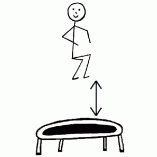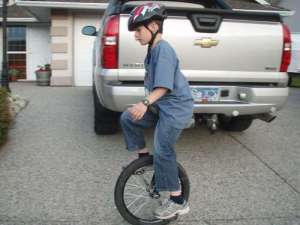
Does your back make you feel like this?
Back pain universally blows. It destroys postures, mental states, and days all around the world.
Sciatica is a subset of back pain mostly felt in the legs. The sciatic nerve is a long nerve that goes through the spine, separating down into the legs and ending in the feet. Sciatica often occurs when something close to the sciatic nerve impinges upon it. The muscles around the nerve, in an attempt to protect it, seize up causing sharp, shooting pain or numbness through the buttocks and the back of the leg. Muscle atrophy can result from the stress of seizing up.

The sciatic nerve
Sciatica and back pain can attack anyone at anytime. A young athletic person with muscular imbalances is as likely to feel back pain as an older person with a sedentary lifestyle.
If ignored, sciatica and back pain often gets worse. With an acute onset of sciatica at 25, I know. Without proper care, I was forced to lay on the floor for a week, unable to sit or stand for long. My leg would buckle underneath me, and even as the pain lessened, I could barely stand for more than an hour or two at a time. It took a year of constant work to become pain free. That year was crucial for understanding how to care my body and preventing back problems for years to come.
Every body is different. Back problems are relative to the individual. Proper core strength, self-knowledge and self-care are golden tickets to recovery.
Below are suggestions to help ease sciatica, but always consult your physician regarding any prolonged back pain.
#1. R-I-C-E – It’s the physical therapy stand-by for acute pain. Practiced everywhere from the school nurse’s office to NBA courts.

REST– After an acute back injury, rest is the best medicine. Allow the spine and muscles to relax and to heal on their own terms. Listen to your body.
ICE– When in doubt, go with ice to help relieve inflammation and numb the pain. My favorite ice pack is a super large bag of corn or peas from the grocer, just don’t eat it later.
COMPRESSION– Wearing a back brace or wrapping an ace bandage in a corset-like fashion can temporarily aid in supporting the spine and muscle strain.
ELEVATION – Rest flat on the back, allowing the legs to be propped up at an ELEVATED angle. Either with a pillow below the knees or lying on the floor with calves draped on the couch or a chair.
#2. Stretch out the spasm.
Stretching out cramping muscles provides temporary relief. Proper stretching is crucial. Do not stretch the leg past a 90 degree angle, causing the low back to curl forward or twist. While this might feel good at the time, it can make the pain worse later by straining the low back. Keep the spine neutral while stretching the legs. Again, when stretching the leg do not allow the low back to round or tuck under.

hamstring stretch. turn the leg in and out
Piriformis stretch: This stretch releases the muscle spasm temporarily around part of the sciatic nerve. Lie on your back. Cross one foot over the opposite thigh. Pull the thigh in towards your chest. It’s very important to keep your tailbone on the floor (do not allow it to curl up off the floor).

Piriformis stretch
#3. Build a better core
Begin to work on slow, controlled movements that allow you to find your core muscles. No crunches or sit ups. Without proper awareness these movement can create further muscular imbalance and continued back pain. I recommend trying the dead bug exercise, which is explained here.

dead bug exercise
#4. McKenzie Exercises
Physical therapists either approve or condemn this method. There seems to be no in between. After 6 months of pain, the McKenzie extension exercises helped my own pain and strengthen my back muscles.

Named after a physical therapist in New Zealand, McKenzie exercises are primarily extension (arching) exercises that could help reduce the symptoms of herniated disc by reducing pressure on a nerve root. For acute pain, the McKenzie exercises should be done frequently, at least once every two hours. For more information, you can buy the book, or check out their website. Although many back and sciatica problems could be helped by these exercises, it is not for everybody. Consult a therapist or a doctor to determine if this method is for you.
#5. Get moving with strength and balance
Once back pain is under control, it’s time to consider exercises to make sure the pain stays away. Understand your body’s muscular balance and how it works: Which muscles need to be strengthened and which need to be stretched? Which are overdeveloped or strained? A strong core includes whole body balance, not just the front abdominal wall. The guidance of a professional Pilates instructor, physical therapist, or movement therapist is highly recommended. Ideas for low impact exercise can include:
walking
elliptical
swimming
pilates (with a certified instructor, preferably one with a rehabilitation background)
low impact aerobics
dance
…really, just get moving! Finding an enjoyable form of exercise is key to lasting strength. Regular activity, with balanced trunk strength, prevents back pain from recurring, allowing you to stay mobile and strong for many years to come.





































































